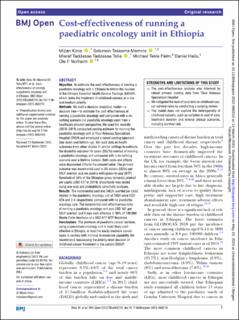| dc.contributor.author | Mirutse, Mizan Kiros | |
| dc.contributor.author | Memirie, Solomon Tessema | |
| dc.contributor.author | Tolla, Mieraf Taddesse | |
| dc.contributor.author | Palm, Michael Tekle | |
| dc.contributor.author | Hailu, Daniel | |
| dc.contributor.author | Norheim, Ole Frithjof | |
| dc.date.accessioned | 2023-05-25T09:05:52Z | |
| dc.date.available | 2023-05-25T09:05:52Z | |
| dc.date.created | 2023-03-30T16:55:53Z | |
| dc.date.issued | 2023 | |
| dc.identifier.issn | 2044-6055 | |
| dc.identifier.uri | https://hdl.handle.net/11250/3068961 | |
| dc.description.abstract | Objective: To estimate the cost-effectiveness of running a paediatric oncology unit in Ethiopia to inform the revision of the Ethiopia Essential Health Service Package (EEHSP), which ranks the treatment of childhood cancers at a low and medium priority.
Methods: We built a decision analytical model—a decision tree—to estimate the cost-effectiveness of running a paediatric oncology unit compared with a do-nothing scenario (no paediatric oncology care) from a healthcare provider perspective. We used the recently (2018–2019) conducted costing estimate for running the paediatric oncology unit at Tikur Anbessa Specialized Hospital (TASH) and employed a mixed costing approach (top-down and bottom-up). We used data on health outcomes from other studies in similar settings to estimate the disability-adjusted life years (DALYs) averted of running a paediatric oncology unit compared with a do-nothing scenario over a lifetime horizon. Both costs and effects were discounted (3%) to the present value. The primary outcome was incremental cost in US dollars (USDs) per DALY averted, and we used a willingness-to-pay (WTP) threshold of 50% of the Ethiopian gross domestic product per capita (USD 477 in 2019). Uncertainty was tested using one-way and probabilistic sensitivity analyses.
Results: The incremental cost and DALYs averted per child treated in the paediatric oncology unit at TASH were USD 876 and 2.4, respectively, compared with no paediatric oncology care. The incremental cost-effectiveness ratio of running a paediatric oncology unit was USD 361 per DALY averted, and it was cost-effective in 90% of 100 000 Monte Carlo iterations at a USD 477 WTP threshold.
Conclusions: The provision of paediatric cancer services using a specialised oncology unit is most likely cost-effective in Ethiopia, at least for easily treatable cancer types in centres with minimal to moderate capability. We recommend reassessing the priority-level decision of childhood cancer treatment in the current EEHSP. | en_US |
| dc.language.iso | eng | en_US |
| dc.publisher | BMJ | en_US |
| dc.rights | Navngivelse-Ikkekommersiell 4.0 Internasjonal | * |
| dc.rights.uri | http://creativecommons.org/licenses/by-nc/4.0/deed.no | * |
| dc.title | Cost-effectiveness of running a paediatric oncology unit in Ethiopia | en_US |
| dc.type | Journal article | en_US |
| dc.type | Peer reviewed | en_US |
| dc.description.version | publishedVersion | en_US |
| dc.rights.holder | Copyright 2023 the authors | en_US |
| dc.source.articlenumber | e068210 | en_US |
| cristin.ispublished | true | |
| cristin.fulltext | original | |
| cristin.qualitycode | 1 | |
| dc.identifier.doi | 10.1136/bmjopen-2022-068210 | |
| dc.identifier.cristin | 2138648 | |
| dc.source.journal | BMJ Open | en_US |
| dc.identifier.citation | BMJ Open. 2023, 13 (3), e068210. | en_US |
| dc.source.volume | 13 | en_US |
| dc.source.issue | 3 | en_US |

